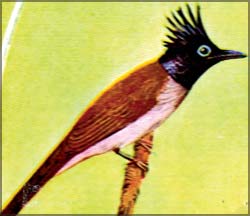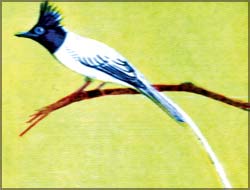A queer bird the Paradise Flycatcher
In India there is a legend which tells us why
the adult Paradise Flycatcher dropped its chestnut colour and adopted a
while plumage, still retaining the blue-black head and crest. Similarly,
among our villagers there is the popular belief that the Kiri-Hora
is a rare resident, which annually sheds its
long tail-streamers and goes into hiding in the heart of the jungle,
until a new tail is grown
K. G. H. Munidasa
Everybody knows and some time or another has seen the Ceylon Paradise
Flycatcher, popularly called 'Gini-Hora' or 'Sivuru-Hora' and 'Piramana
Kuruvi' in Tamil, though there would be many who may have never seen its
brother 'Kiri-Hora' or 'Sudu Redhi-Hora'. And, of course, the latter is
the more striking of the two.
In stance and behaviour, there is hardly any difference between the
two forms, except that one is chestnut and the other white in
colouration.
|

Ceylon Paradise Flycatcher (male) at nest |
Kiri-Hora
In India there is a legend which tells us why the adult Paradise
Flycatcher dropped its chestnut colour and adopted a while plumage,
still retaining the blue-black head and crest. Similarly, among our
villagers there is the popular belief that the Kiri-Hora is a rare
resident, which annually sheds its long tail-streamers and goes into
hiding in the heart of the jungle, until a new tail is grown.
The fact is that the white flycatcher is purely a migrant in Sri
Lanka, arriving here in Winter (December-February) and returning to its
breeding grounds in Spring (March-May).
Birdwatcher
The average birdwatcher, who looks at a White Paradise Flycatcher for
the first time is liable to take for granted that it was born like that.
It is not so. Irrespective of sex, young of both the Indian race
paradisi and the Lankan race Ceylonensis are generally chestnut with
blue-black heads and whitish underparts at birth.
After the first annual moult, the two central feathers of the male
begin to lengthen and grow to an approximate length of 12 to 15 inches,
with the second moult. In the third year moult the male of the Indian
race gradually changes from chestnut to white plumage, and by the fourth
moult it becomes completely white, except the head, neck and crest,
which remain glossy blue-black.
Bi-colour birds
Meanwhile, males of the Lankan race and the females of both the races
continue in the chestnut plumage throughout their life.
The females do not carry long tail streamers like the males. Bi-colour
birds or individuals in intermediate plumage have, however been observed
in Sri Lanka on many an occasion. For example, a male observed by me in
the Gal Oya valley in 1965 sported long tail streamers, one of which was
chestnut and the other pure white.
A female seen at a home garden in the Low-Country Wet Zone in
November 1991 possessed white feathering on the lower back, while some
scapulars and a single greater covert on her left wing were
conspicuously white.
Douglas Raffel, author of that fascinating book The Ruhunu Jungles
recalls having been told him by a friend that several decades ago he had
come across in the Batticaloa District a White Paradise Flycatcher
brooding eggs in a nest. If the observation was correct, perhaps the
Indian race nested in the island during the off season from December to
January.
Major W. W. A. Phillips, an authority on the birdlife of India and
Sri Lanka blatantly rejects this supposition and claims that the Indian
race would never be found breeding in Sri Lanka.
The Paradise Flycatcher Terpsiphone paradisi is found in Turkestan,
Afghanistan and Baluchistan, through the greater part of India to Burma
and still further
|
 
Ceylon Paradise
Flycatcher Male and female (Above and right) |
Eastwards.
Indian region
Three forms are described from the Indian region, out of which the
typical race paradisi occurs in the hills and dales of peninsula India
and visits Sri Lanka during the North-East Monsoon.
The race Leucogaster, which differs from the first mentioned in size
and details of colouration inhabits Turkestan, Kashmir and through the
Himalayas to East Nepal.
The other Nicobarica, which has the head, neck and breast ashy-grey
with only the cap and crest black is found in Assam, migrating to the
Nicobars and Andaman Islands in winter. The race Ceylonensis is endemic
to this island.
Lankan race
Within its breeding range the Paradise Flycatcher moves about a great
deal. Thus with different localities in India it holds different status.
In one place it is a 'Summer Visitor', a 'Passage Migrant' in another,
and still in another locality it is called a 'Scares Winter Visitor'.
This seasonal movement is evident even in the Lankan race. For instance,
in the North-East Monsoon period the Paradise Flycatchers disperse all
over the wet and dry zones, and the Hills to a level of at least 3,700
feet elevations.
About March to April they begin to move out again and concentrate in
the forest tracts of the drier areas, where they pair and breed during
May to June. |



